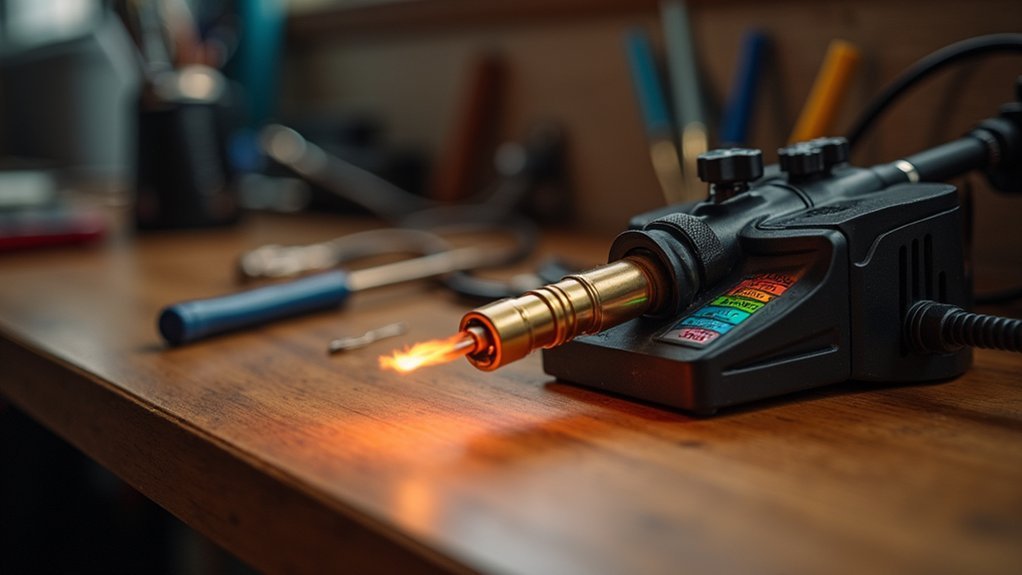You’ll achieve perfect torch temperature control by adjusting your flame size based on project scale—use smaller flames for delicate components and wider flames for larger pieces. Maintain a 2-3 inch distance at a 45-degree angle from your workpiece while applying heat to the base metal rather than directly on solder. Monitor temperatures carefully: stick to 315-370°C for easy soldering, 650-800°C for silver, and up to 1000°C for gold. Use continuous circular movements to distribute heat evenly and prevent localized overheating that damages components. These fundamentals reveal advanced techniques that’ll elevate your craftsmanship.
Flame Size Adjustment Techniques for Different Jewelry Projects

Three key factors determine your success when adjusting flame size for jewelry soldering: the scale of your project, the delicacy of your components, and the specific temperature requirements of your metals.
For larger jewelry projects, you’ll benefit from using a wider flame with a rosebud tip to create even heat distribution across broader surfaces.
When working with delicate components, start with smaller flames to prevent damage and distortion.
Master control of your torch by adjusting the control knob to maintain temperatures between 315-370°C for ideal metal soldering.
Utilize your torch’s flame lock feature for sustained heating without continuous pressure, improving precision while enhancing fuel efficiency.
Regular flame size adjustment guarantees consistent performance regardless of air composition variations.
Proper Distance and Angle Control Between Torch and Workpiece
While flame size sets the foundation for successful soldering, your torch’s distance and angle from the workpiece determine whether you’ll achieve precise, clean joints or end up with damaged components.
Maintain proper distance of 2-3 inches between your torch tip and workpiece. This spacing delivers ideal heat transfer without overheating. You’ll want to position the torch at approximately 45 degrees to facilitate even heating and prevent concentrated heat damage.
| Distance | Angle | Temperature Setting | Result |
|---|---|---|---|
| 2-3 inches | 45 degrees | 315-370°C | Ideal heating |
| Too close | Any angle | High heat | Component damage |
| Too far | Any angle | Low heat | Poor solder flow |
| Proper distance | Wrong angle | Right temperature | Uneven heating |
Use sweeping motions to distribute heat evenly. Confirm you know that prolonged focus creates warping and excessive solder flow.
Heat Application Methods to Maximize Capillary Action in Solder Joints

Once you’ve mastered distance and angle control, the way you apply heat becomes critical for achieving strong capillary action in your solder joints. Focus your torch primarily on the base metal rather than directly heating the solder itself. This technique guarantees the copper reaches the proper temperature of around 450°C, creating ideal conditions for solder flow.
Use a rosebud tip for even heat distribution and steady flame application across the entire joint area. Monitor temperatures carefully—while you need sufficient heat for capillary action, excessive temperatures above 1200°C cause oxidation and compromise joint integrity.
Most soldering operates effectively at low temperatures between 315-370°C, well below the melting point of copper. Place the solder strategically and watch for flow, then reduce flame intensity to maintain control.
Temperature Monitoring for Various Jewelry Metals and Solder Types
Each jewelry metal and solder type demands specific temperature ranges to achieve ideal bonding without compromising the material’s integrity. You’ll need precise temperature monitoring to prevent overheating and oxidation damage. Silver soldering requires 650-800°C, while gold demands much higher temperatures up to 1000°C. Copper, commonly found in copper pipes and jewelry applications, needs temperatures above its 1085°C melting point for effective bonding.
| Solder Type | Temperature Range | Application |
|---|---|---|
| Easy Solder | 315-370°C | Delicate work |
| Medium Solder | 430-460°C | General purpose |
| Hard Solder | 600-650°C | Structural joints |
Use adjustable flame torches like the Turbo Torch for fine temperature control. Monitor heat application carefully—too much causes weak joints and material damage.
Torch Movement Patterns for Even Heat Distribution Across Components

Achieving proper temperatures means nothing if you can’t distribute that heat evenly across your workpiece. Effective torch movement patterns guarantee consistent heating throughout your soldering process. Move your torch in circular or sweeping motions, maintaining 1 to 2 inches distance from components. Keep the torch moving continuously—never hold it stationary over one spot.
For larger surfaces, use back-and-forth motions to promote even heating. This technique works especially well with copper and materials requiring higher temperatures.
Adjust your movement speed based on material thickness: move slower over thick sections, faster over thin areas. This approach allows you to achieve uniform results at lower temperatures than static heating methods, preventing localized overheating while guaranteeing proper solder flow across all components.
Frequently Asked Questions
What Are the Best Temperatures for Soldering?
You’ll want to start between 315-370°C for basic soldering tasks. For metal brazing, you’ll need temperatures exceeding 450°C. Always monitor your solder’s flow and adjust accordingly for best results.
What Is the Best Heat Source for Soldering?
You’ll want a propane torch as your best heat source for soldering. Choose one with self-ignition, flame control, and pressure regulation for precise temperature management between 315°C and 450°C.
Is a Propane Torch Hot Enough to Solder?
Yes, you’ll find a propane torch is definitely hot enough for soldering. It reaches over 1200°C, far exceeding the 315-370°C you need for effective soldering applications and proper solder flow.
Where Is the Hottest Point on a Torch?
The hottest point on your torch is at the tip’s inner cone, where combustion’s most efficient. You’ll find temperatures reaching 2000°C with air-fed torches, making this area perfect for concentrated heat application.
In Summary
You’ll master torch temperature control by practicing these five essential techniques regularly. Adjust your flame size based on your project’s scale, maintain proper distance and angles, and focus heat application to encourage solder flow. Don’t forget to monitor temperatures for different metals and move your torch in consistent patterns. With dedicated practice, you’ll develop the muscle memory and intuition needed for professional-quality soldering results every time.





Leave a Reply